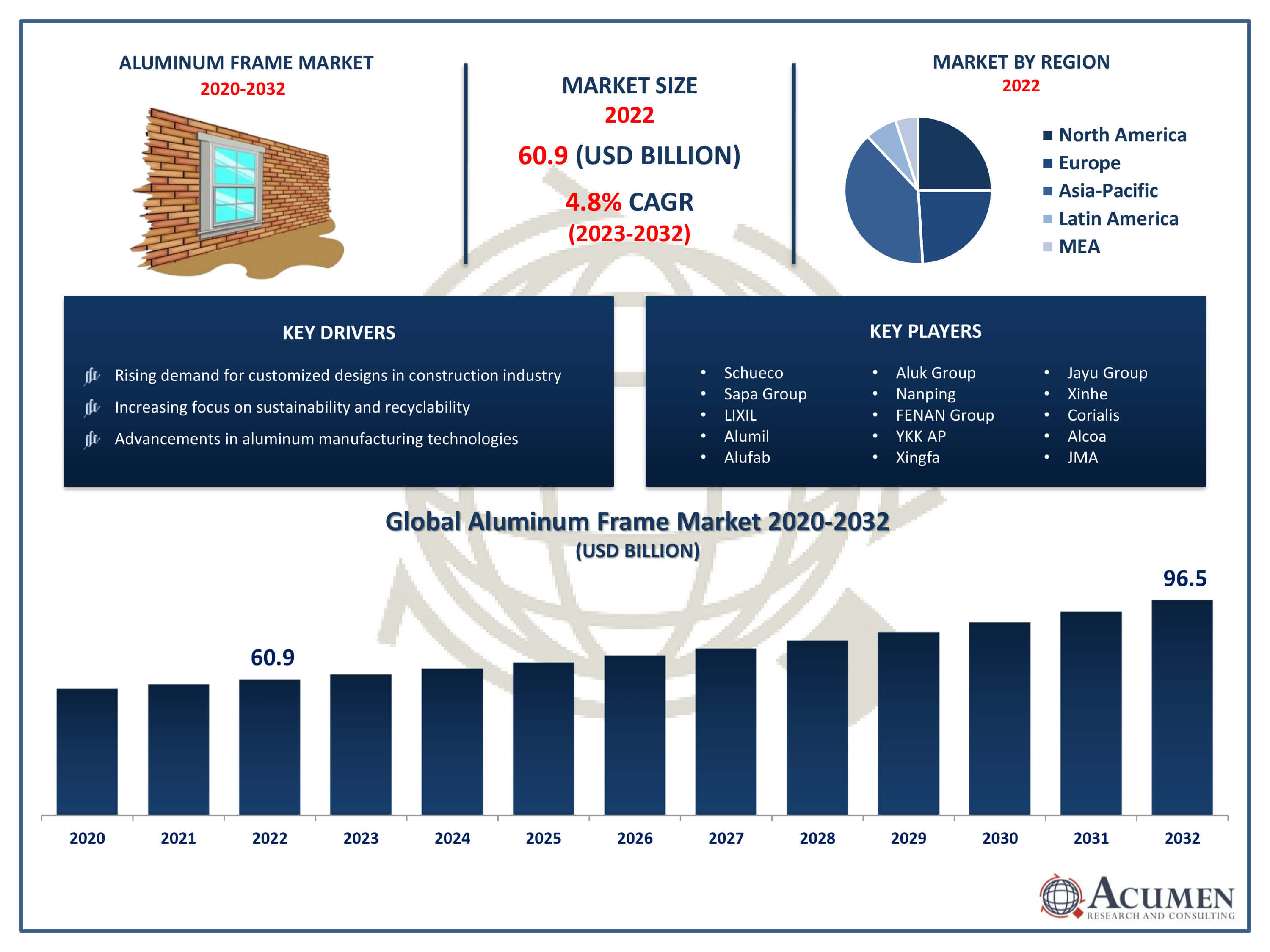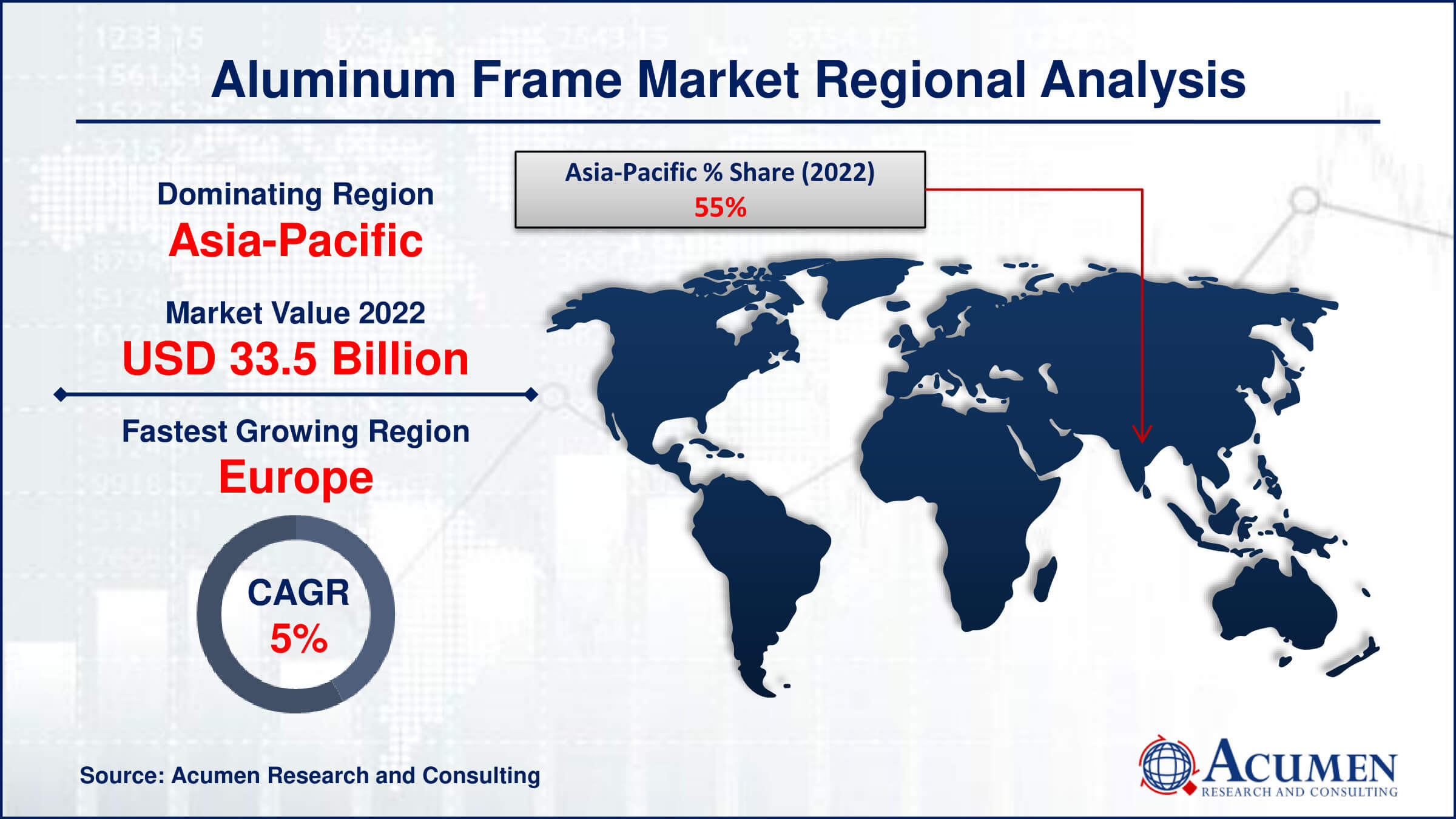March 2024
Aluminum Frame Market Size accounted for USD 60.9 Billion in 2022 and is projected to achieve a market size of USD 96.5 Billion by 2032 growing at a CAGR of 4.8% from 2023 to 2032.
The Aluminum Frame Market Size accounted for USD 60.9 Billion in 2022 and is projected to achieve a market size of USD 96.5 Billion by 2032 growing at a CAGR of 4.8% from 2023 to 2032.
Aluminum Frame Market Highlights

An aluminum frame refers to a structural framework predominantly constructed using aluminum as the primary material. Aluminum frames find extensive use in various industries, including construction, automotive, aerospace, and consumer goods. Their popularity stems from several advantageous properties of aluminum, such as its lightweight nature, high strength-to-weight ratio, corrosion resistance, and recyclability. These characteristics make aluminum frames ideal for applications where durability, reliability, and weight savings are essential, such as in the manufacturing of bicycles, automobiles, aircraft, windows, doors, and structural components in buildings.
In recent years, the market for aluminum frames has experienced significant growth driven by several factors. One key driver is the increasing demand for lightweight materials in various industries to improve fuel efficiency, reduce emissions, and enhance overall performance. Additionally, the growing emphasis on sustainable practices and environmental consciousness has led to a surge in the adoption of aluminum frames due to their recyclability and relatively low environmental impact compared to other materials like steel. Moreover, advancements in aluminum manufacturing processes, such as extrusion and fabrication techniques, have enabled the production of complex and customized designs, further expanding the application scope of aluminum frames across different sectors.
Global Aluminum Frame Market Trends
Market Drivers
Market Restraints
Market Opportunities
Aluminum Frame Market Report Coverage
| Market | Aluminum Frame Market |
| Aluminum Frame Market Size 2022 | USD 60.9 Billion |
| Aluminum Frame Market Forecast 2032 | USD 96.5 Billion |
| Aluminum Frame Market CAGR During 2023 - 2032 | 4.8% |
| Aluminum Frame Market Analysis Period | 2020 - 2032 |
| Aluminum Frame Market Base Year |
2022 |
| Aluminum Frame Market Forecast Data | 2023 - 2032 |
| Segments Covered | By Type, By Application, And By Geography |
| Regional Scope | North America, Europe, Asia Pacific, Latin America, and Middle East & Africa |
| Key Companies Profiled | Schueco, Sapa Group, LIXIL, Alumil, Alufab, Aluk Group, Nanping, FENAN Group, YKK AP, Xingfa, Jayu Group, Xinhe, Corialis, Alcoa, JMA, and Wacang |
| Report Coverage |
Market Trends, Drivers, Restraints, Competitive Analysis, Player Profiling, Covid-19 Analysis, Regulation Analysis |
Aluminum frames find extensive applications across various industries due to their versatility and advantageous properties. In construction, aluminum frames are commonly used for windows, doors, curtain walls, and structural components, offering a combination of strength, durability, and aesthetic appeal. Additionally, in the automotive sector, aluminum frames are employed in vehicle chassis, body structures, and engine components to reduce weight, enhance fuel efficiency, and improve overall performance. Their lightweight nature also makes them ideal for applications in aerospace, where every ounce saved can translate into significant fuel savings over the lifespan of an aircraft. Beyond construction and automotive, aluminum frames have diverse applications in consumer goods, electronics, and transportation. In consumer electronics, aluminum frames are often utilized in the manufacturing of smartphones, laptops, and tablets due to their sleek design, lightweight construction, and durability. Moreover, aluminum frames play a crucial role in the production of bicycles, where they provide a sturdy yet lightweight framework for riders.
The aluminum frame market has been experiencing steady growth in recent years, fueled by a combination of factors driving demand across various industries. One significant contributor to this growth is the increasing preference for lightweight materials, particularly in sectors like automotive, aerospace, and consumer electronics. Aluminum's exceptional strength-to-weight ratio makes it an attractive choice for manufacturers seeking to improve fuel efficiency, enhance performance, and reduce emissions in their products. As a result, there has been a surge in the adoption of aluminum frames in applications ranging from vehicle chassis and aircraft structures to smartphones and laptops. Furthermore, the emphasis on sustainability and environmental responsibility has further propelled the market forward. Aluminum is highly recyclable, with recycled aluminum requiring significantly less energy to produce compared to primary aluminum. This eco-friendly characteristic has led to growing interest from both consumers and regulatory bodies, encouraging manufacturers to incorporate aluminum frames into their product designs.
Aluminum Frame Market Segmentation
The global Aluminum Frame Market segmentation is based on type, application, and geography.
Aluminum Frame Market By Type
In terms of types, the exterior walls segment accounted for the largest market share in 2022. One key driver of this growth is the increasing demand for high-performance building materials that offer durability, energy efficiency, and aesthetic appeal. Aluminum frames provide a versatile solution for exterior walls, offering strength, corrosion resistance, and the ability to withstand harsh weather conditions, making them particularly suitable for use in both residential and commercial buildings. Moreover, the trend towards sustainable construction practices has further propelled the adoption of aluminum frames in exterior walls. Aluminum is inherently recyclable, contributing to green building initiatives aimed at reducing environmental impact. Additionally, advancements in aluminum frame technology, such as thermal break systems and improved insulation properties, have enhanced energy efficiency in buildings, aligning with stringent regulatory standards and green building certifications. As architects and developers prioritize energy-efficient and environmentally friendly construction materials, the demand for aluminum frames in exterior walls is expected to continue its upward trajectory.
Aluminum Frame Market By Application
According to the aluminum frame market forecast, the commercial segment is expected to witness significant growth in the coming years. Aluminum frames are highly favored in commercial applications due to their versatility, durability, and aesthetic appeal. In sectors such as office buildings, retail spaces, and hospitality establishments, aluminum frames offer architects and developers a wide range of design options while ensuring structural integrity and long-term performance. One of the key factors fueling the growth of aluminum frames in the commercial segment is the increasing demand for sustainable and energy-efficient building solutions. Aluminum's recyclability and ability to support energy-saving glazing systems make it a preferred choice for green building initiatives and projects seeking LEED certification. Additionally, advancements in aluminum frame technology, such as thermally broken frames and enhanced insulation, have further boosted energy efficiency in commercial buildings, aligning with stringent regulatory requirements and the growing emphasis on environmental responsibility. Furthermore, the commercial sector's shift towards modern, sleek architectural designs has also contributed to the rise of aluminum frames.
Aluminum Frame Market Regional Outlook
North America
Europe
Asia-Pacific
Latin America
The Middle East & Africa

Aluminum Frame Market Regional Analysis
The Asia-Pacific region has emerged as a dominating force in the global aluminum frame market, fueled by several factors contributing to its rapid growth and expansion. One of the primary drivers of the region's dominance is the unprecedented pace of urbanization and infrastructure development across countries like China, India, and Southeast Asian nations. As these economies experience robust growth and industrialization, there is a soaring demand for construction materials, including aluminum frames, to support the burgeoning urban landscape and meet the needs of rapidly expanding populations. Moreover, the Asia-Pacific region benefits from a thriving manufacturing sector, with many of the world's leading aluminum frame producers and suppliers based in countries like China and Japan. These nations boast advanced manufacturing capabilities and technological expertise, allowing them to produce high-quality aluminum frames at competitive prices. As a result, the region has become a hub for aluminum frame production, catering not only to domestic demand but also exporting to markets around the globe. Additionally, supportive government policies and initiatives promoting sustainable development and green building practices have further propelled the growth of the aluminum frame market in the Asia-Pacific region.
Aluminum Frame Market Player
Some of the top aluminum frame market companies offered in the professional report include Schueco, Sapa Group, LIXIL, Alumil, Alufab, Aluk Group, Nanping, FENAN Group, YKK AP, Xingfa, Jayu Group, Xinhe, Corialis, Alcoa, JMA, and Wacang.
Looking for discounts, bulk pricing, or custom solutions? Contact us today at sales@acumenresearchandconsulting.com
March 2024
August 2021
April 2024
May 2020